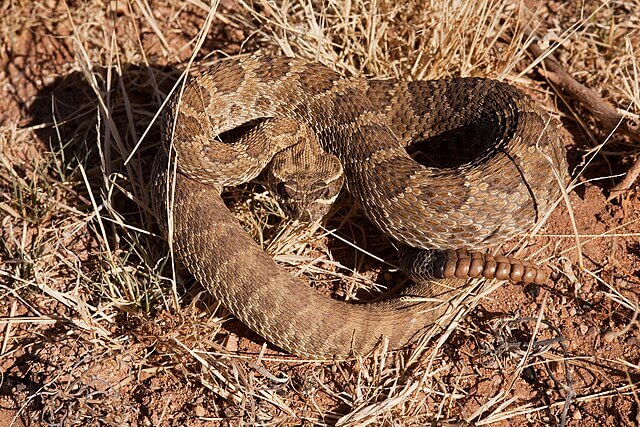Camping in Rattlesnake Country
By Caroline Kurtz
Aired 10.2001, 10.2007, 10.2010, 10.2017, and 9.6 & 9.9.2023

Photo by Patrick Alexander, public domain.
Listen:
My husband is an herpetophile. He’s been “snake crazy” since he was a kid, as he’s often fond of saying. While I’m not particularly phobic about them, I never had much experience with snakes of any kind until I moved to Montana, and I’m sure I harbor many misconceptions about their habits.
This summer, we spent a lot of time in eastern Montana, fishing and camping in the foothills of the Rocky Mountains—prime rattlesnake country. One morning as I was shaking out a ground cloth in preparation for setting up our tent a distinct buzzing sound—not that loud but definitely unlike the sound of the wind through the grass or any insect or bird—stopped me cold. I’m not sure I’d ever even heard a rattlesnake in the flesh before, but my body knew it before my brain did. I looked carefully but didn’t see anything. I waited but heard nothing more. I thought perhaps I’d been mistaken so continued with the tent. Within a minute another buzz, this time a little more insistent. And this time I did see the cause. A five- or six-foot prairie rattlesnake moving unhurriedly off, not too concerned, just giving me notice. His brown and greenish coloration perfectly matched the surrounding dirt and grass. He was probably on a morning route between the river and a nearby hillside of exposed sandstone and shrubs. We watched him go and for the remainder of our time there we did not cross paths again—to our mutual relief I’m sure.
Starting in October prairie rattlesnakes congregate in dens, piling into cracks and crevices in rock walls that may have served the same over-wintering purpose for thousands of years. In May, they emerge from total darkness and spend a few weeks warming up and resetting their biological clocks, orienting to the sun before setting off on their separate ways in search of food and mates. A snake may migrate many miles from its hibernating place, moving in a straight line, continually testing for the presence of prey by using the sensitive organs on the roof of its mouth. Once snakes reach a place where the concentration of prey seems adequate, they remain, searching out ground squirrels, deer mice, rabbits and other groceries. These summer feeding grounds may also be staging areas from which snakes make forays to find a mate—sometimes a tricky proposition for the males, since in any year only half of the female population is available to mate. The other half is pregnant and remain in rookeries near their hibernating place to give birth to live young in late August and September. Females can also store sperm and so don’t necessarily need to breed every year in order to produce offspring—making it that much tougher on the males.
Come autumn, not long after the young of the year are born, the adults begin to return to their time-tested dens, ensuring their survival for another spring. It appears that communal hibernation and birthing aggregations are unique to snakes living in extreme climates and that it is behavior evolved to cope with harsh conditions.
Every week since 1991, Field Notes has inquired about Montana’s natural history. Field Notes are written by naturalists, students, and listeners about the puzzle-tree bark, eagle talons, woolly aphids, and giant puffballs of Western, Central and Southwestern Montana and aired weekly on Montana Public Radio.
Click here to read and listen to more Field Notes. Field Notes is available as a podcast! Subscribe on Apple Podcasts or wherever you listen to podcasts.
Interested in writing a Field Note? Contact Allison De Jong, Field Notes editor, at adejong [at] montananaturalist [dot] org or 406.327.0405.
Want to learn more about our programs as well as fun natural history facts and seasonal phenology? Sign up for our e-newsletter! You can also become a member and get discounts on our programs as well as free reciprocal admission to 300+ science centers in North America!












